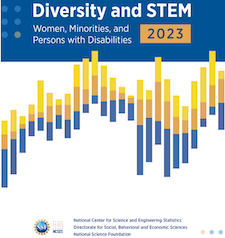Women Making Progress in STEM Education and Occupations, But More Work Needs to Be Done
Posted on Feb 08, 2023 | Comments 0
 The National Science Foundation has released a new report entitled Diversity and STEM: Women, Minorities, and Persons with Disabilities 2023.
The National Science Foundation has released a new report entitled Diversity and STEM: Women, Minorities, and Persons with Disabilities 2023.
“Diversity is America’s unique advantage in science and technology,” said Sethuraman Panchanathan, director of the National Science Foundation. “Our global leadership depends upon diversity, leveraging different backgrounds, experiences, and points of view to bring unique insights to problem solving and discovery. The Diversity and STEM report provides objective, reliable data on where our nation has made progress towards access and equity in STEM education and careers, as well as where we must do more.”
The report shows more women, as well as Black, Hispanic, American Indian, and Alaska Native people collectively, worked in STEM jobs over the past decade, diversifying that workforce, and are earning more degrees in science and engineering fields at all levels compared to previous years. However, those groups broadly remain underrepresented in science, technology, engineering, and mathematics when compared to their overall distribution in the U.S. population, reflecting the larger equity challenges our nation faces.
The report suggests women in particular have made significant progress over the past decade, both in terms of increased representation in the STEM workforce and in their participation in higher education. However, those broad patterns are not universal across all STEM occupations and fields of study. For example, women make up much smaller proportions of the college-educated workforce in the computer and mathematical sciences, biological sciences, physical sciences, and engineering compared to the social sciences.
Women earned half of science and engineering bachelor’s degrees (50 percent) and associate’s degrees (49 percent). The number of science and engineering degrees earned by women between 2011 and 2020 increased by 63 percent at the associate’s level, 34 percent at the bachelor’s level, 45 percent at the master’s degree level, and 18 percent at the doctorate level. Women continued to pursue advanced degrees in science and engineering fields in increasing numbers during the COVID-19 pandemic.
But in 2021 women, who were 51 percent of the population, represented about one-third of the STEM workforce. Among the college-educated workforce in science and engineering occupations in 2021, women’s representation ranged from a high of 61 percent among social and related scientists to a low 16 percent among engineers. In addition, women’s wages were consistently lower than men’s.
Filed Under: Gender Gap • Research/Study • STEM Fields








